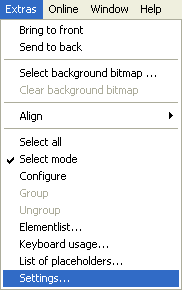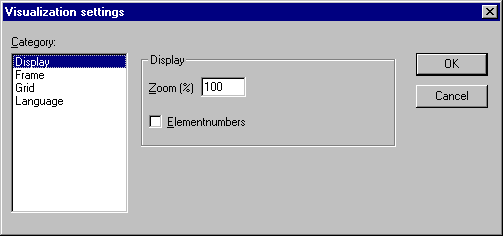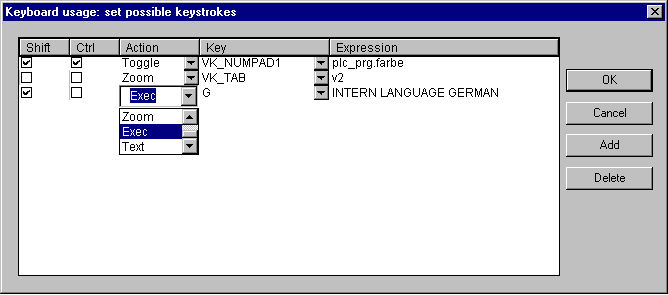Configure Visualization Object
Besides the configuration of the individual visualization elements also the visualization object on the whole can get configured. This is possible concerning the settings for frame, language, grid, background etc. as well as the assignment of special hotkey definitions (keyboard usage), which should be valid for exactly one visualization object.

'Extras' 'Settings' / Display, Frame, Grid, Language
When this command is used, a dialog box will open in which you can make certain settings that affect the visualization.
 | The categories Display, Frame and Language also can be edited in the online mode. |
Category Display :
Enter a zoom factor into the field Zoom of between 10 and 500 % in order to increase or decrease the size of the visualization display.

Setting dialog for visualizations (Category Display)
Category Frame:
If Auto-scrolling is selected, the visible portion of the visualization window will move automatically when you reach the edge while drawing or moving a visualization element. If Best fit in Online mode is selected, the entire visualization including all elements will be shown in the window in Online mode regardless of the size of the window. When Include Background Bitmap is selected, the background bitmap will be fitted into the window as well, otherwise only the elements will be considered.
Category Grid:
Define here whether the grid points are visible in the offline mode, whereby the spacing between the visible points is at least 10 even if the entered size is smaller than that. In this case the grid points only appear with a spacing which is a multiple of the entered size. Selecting Active causes the elements to be placed on the snap grid points when they are drawn and moved. The spacing of the grid points is set in the field Size.
Language category:
Here you can specify in which national language the text that you have assigned to an element in the Text and Text for tooltip options in the configuration dialog should be displayed. Statically, this can be done by using a language file. The function 'Dynamic texts' alternatively offers the possibility to let the content of a text display change depending on a project variable. See chapter Language selection
 | The text display changes only in Online mode! |
'Extras' 'Select Background Bitmap'
Use this command to open the dialog box for selecting files. Select a file with the extension "*.bmp". The selected bitmap will then appear as the background in your visualization.
The bitmap can be removed with the command 'Extras' 'Clear Background Bitmap'.
'Extras' 'Clear Background Bitmap'
Use this command to remove the bitmap as the background for the current visualization.
You can use the command 'Extras' 'Select Background Bitmap' to select a bitmap for the current visualization.
'Extras' 'Keyboard usage'
The use of hotkeys can optimize the pure keyboard operation of a visualization.
In the configuration of a visualization object you can define hotkeys which will cause actions like visualization elements do. For example you could define that – if visualization 'xy' is active – in online mode the hotkey <Strg><F2> will stop the program, which also will happen as soon as element 'z' of visu 'xy' gets an input (by mouse-click or via touch screen).
Anyway per default the keys <Tabulator> <Space> <Enter> will work in that way that in online mode each element of a visualization can be selected and activated.
The dialog 'Keyboard usage: set possible keystrokes' can be called in the menu 'Extras' or in the context menu:

Dialog 'Keyboard usage: set possible keystrokes'
In column Key a selection list offers the following keys to which an action can get assigned:
Shortcut | Meaning |
|---|---|
VK_TAB | Tab-Key |
VK_RETURN | Enter-Key |
VK_SPACE | Space-Key |
VK_ESCAPE | Esc-Key |
VK_INSERT | Insert.-Key |
VK_DELETE | Delete-Key |
VK_HOME | Pos1-Key |
VK_END | End-Key |
VK_PRIOR | Picture () Button |
VK_NEXT | Picture (¯) Button |
VK_LEFT | Arrow-Key (¬) |
VK_RIGHT | Arrow-Key (®) |
VK_UP | Arrow-Key() |
VK_DOWN | Arrow-Key(¯) |
VK_F1-VK_F12 | Function keys F1 to F12 |
0-9 | Keys 0 to 9 |
A-Z | Keys A to Z |
VK_NUMPAD0 - VK_NUMPAD9 | Keys 0 to 9 of the numeric keypad |
VK_MULTIPLY | Key* of the numeric keypad |
VK_ADD | Key+ of the numeric keypad |
VK_SUBTRACT | Key- of the numeric keypad |
VK_DIVIDE | Key of the numeric keypad |
In the columns Shift and Ctrl you can add the <Shift>- and/or the <Ctrl>-key to the already chosen key, so that a key combination will result.
In column Action you define what should happen as soon as the key (combination) will be pressed. Select the desired action from the list and insert an appropriate expression. See in the following the available actions and valid expressions, corresponding to those which can be set in the configuration dialog of category 'Input':
Action | Meaning | Expression |
|---|---|---|
Toggle | Toggle variable | Variable, e.g. "plc_prg.tvar" |
Tap true | Tap variable (set to TRUE) | Program variable, e.G. "plc_prg.svar" |
Tap false | Tap variable (set to FALSE) | Program variable, e,G. "plc_prg.xvar" |
Zoom | Zoom to Vis. | Name of the visualization object to which you want to jump, e.g. "Visu1" |
Exec | Execute Program | Name of the executable file, e.g. "notepad C:\help.txt" (Notepad will start and open the file help.txt) |
Text | Text input of variable 'Textdisplay' | Number of the element for which the text input is to be configured, e.g. "#2" (Display of element numbers can be switched on in 'Extras' 'Settings'; also see 'Element list...') |
In column Expression you must enter – depending on the type of action – a variable name, a INTERN-command, a visualization name of a text string, exactly like you would do in the configuration dialog of category 'Input' for the corresponding visualization element.
Use button Add to add another empty line at the end of the table. Use the Delete button to remove the line where the cursor is positioned currently. OK resp. Cancel will save resp. not save the done settings and close the dialog.
The keyboard usage can be configured separately for each visualization object. Thus the same key (combination) can start different actions in different visualization.
Example:
The following key configurations have been done for the visualizations VIS_1 and VIS_2:
|
VIS_1: | ||||
|---|---|---|---|---|
|
Shift |
Ctrl |
Action |
Key |
Expression |
|
x |
|
Toggle |
A |
PLC_PRG.automatic |
|
|
x |
Zoom |
Z |
VIS_2 |
|
VIS_2: | ||||
|---|---|---|---|---|
|
Shift |
Ctrl |
Action |
Key |
Expression |
|
|
|
Exec |
E |
INTERN LANGUAGE DEUTSCH |
|
|
x |
Zoom |
Z |
TC_VISU |
If you now go online and set the focus to VIS_1, then pressing <Shift><A> will cause that variable PLC_PRG.automatic will be toggled. <Ctrl><Z> will cause a jump from Visu1 to VIS_2.
If VIS_2 is the active window, pressing key <E> will cause that the language within the visualization will switch to German. <Ctrl><Z> here will cause a jump to visualization TC_VISU.